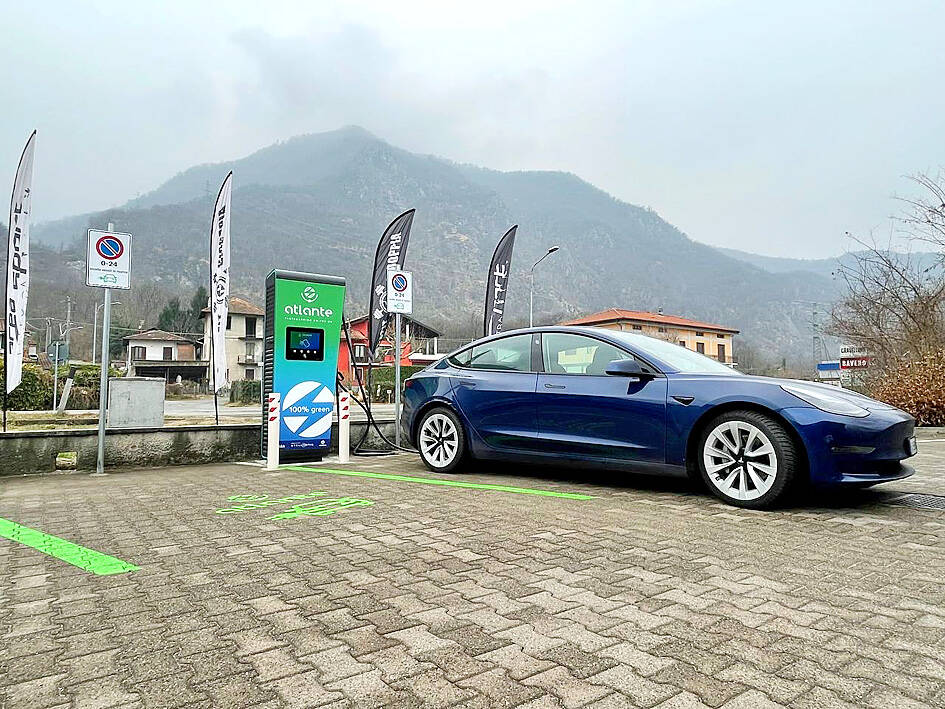A company affiliated with Taiwan Cement Corp (台灣水泥) has received 22.7 million euros (US$22.67 million) from an EU fund to install electric vehicle (EV) charging stations in Europe, Taiwan Cement said yesterday.
Atlante Co, a unit of Taiwan Cement affiliate NHOA SA, was awarded the funds under the EU’s Connecting Europe Facility for Transport scheme, which cofinances investments for the completion and modernization of the Trans-European Transport Network, Taiwan Cement said.
Atlante has been awarded two contracts to install 215 charging stations — 70 in Italy, 55 in France, 55 in Spain and 35 in Portugal — it said.

Photo courtesy of Taiwan Cement Corp
The charging stations are to be placed in 1,400 parking spaces, and placed in safe and secure sites along the transport network.
The stations are to be integrated into national power grids, creating one of the world’s largest virtual power plants, Taiwan Cement said.
The stations are planned to be powered by renewable energy sources, with on-site battery storage as well as on-site or off-site solar energy production, it said.
The fast and ultra-fast charging network would allow drivers to charge their electric vehicles in a matter of minutes, similar to stopping at a gas station for fuel, the company said.
The EU aims to reduce its carbon emissions by 90 percent by 2050, and plans to transition to alternative and lower-carbon fuels, as transportation accounts for 70 percent of its total emissions, it said.
Through the EU’s Alternative Fuels Infrastructure Facility, 292.5 million euros of funds are to be awarded to 24 projects, ranging from the installation of EV charging stations and hydrogen fuel stations to the electrification of ground handling services at airports, Taiwan Cement said.

UNCERTAINTY: Investors remain worried that trade negotiations with Washington could go poorly, given Trump’s inconsistency on tariffs in his second term, experts said The consumer confidence index this month fell for a ninth consecutive month to its lowest level in 13 months, as global trade uncertainties and tariff risks cloud Taiwan’s economic outlook, a survey released yesterday by National Central University found. The biggest decline came from the timing for stock investments, which plunged 11.82 points to 26.82, underscoring bleak investor confidence, it said. “Although the TAIEX reclaimed the 21,000-point mark after the US and China agreed to bury the hatchet for 90 days, investors remain worried that the situation would turn sour later,” said Dachrahn Wu (吳大任), director of the university’s Research Center for

Alchip Technologies Ltd (世芯), an application-specific integrated circuit (ASIC) designer specializing in artificial-intelligence (AI) chips, yesterday said that small-volume production of 3-nanometer (nm) chips for a key customer is on track to start by the end of this year, dismissing speculation about delays in producing advanced chips. As Alchip is transitioning from 7-nanometer and 5-nanometer process technology to 3 nanometers, investors and shareholders have been closely monitoring whether the company is navigating through such transition smoothly. “We are proceeding well in [building] this generation [of chips]. It appears to me that no revision will be required. We have achieved success in designing

PROJECTION: KGI Financial said that based on its foreign exchange exposure, a NT$0.1 increase in the New Taiwan dollar would negatively impact it by about NT$1.7 billion KGI Financial Holding Co (凱基金控) yesterday said its life insurance arm has increased hedging and adopted other moves to curb the impact of the local currency’s appreciation on its profitability. “It is difficult to accurately depict the hedging costs, which might vary from 7 percent to 40 percent in a single day,” KGI Life Insurance Co (凱基人壽) told an investors’ conference in Taipei. KGI Life, which underpinned 66 percent of the group’s total net income last year, has elevated hedging to 55 to 60 percent, while using a basket of currencies to manage currency volatility, the insurer said. As different

Taiwanese insurers are facing difficult questions about the damage of recent swings in the New Taiwan dollar. Regulators might have a partial solution: letting firms change how they calculate the value of foreign currency assets. The Financial Supervisory Commission (FSC) is considering allowing insurers to use six-month average exchange rates when they calculate risk-based capital in their semiannual reports, a shift from the current system where insurers use exchange rates on the final day of reporting. The change could ease pressure on the US$1.2 trillion insurance sector, whose huge exposure to foreign assets came into the spotlight earlier this month after a